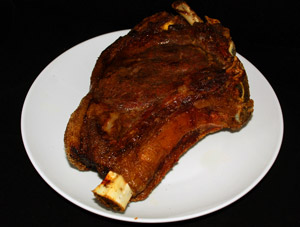 Rare roast beef is by far my favourite food. It is one of the highlights of my low-carb diet. I love eating it, whether hot or cold. I always roast a huge chunk, so that there are leftovers to keep in the fridge for eating cold.
Rare roast beef is by far my favourite food. It is one of the highlights of my low-carb diet. I love eating it, whether hot or cold. I always roast a huge chunk, so that there are leftovers to keep in the fridge for eating cold.
Over the years, I think I mastered the art of roasting beef (even though I do say so myself). I get compliments on my roast beef from people far less carnivorous than myself. So I thought I’d share my method with you. There are only a few basic rules – they are all very simple but vital for the result.
1. Get good quality meat from a butcher
This one is a bit of a no-brainer, but it is very important. It is well worth spending extra to get an organic and preferably grass-fed chunk of beef. Ideally, with a bone still in. And with a solid thick layer of fat on top.
The difference from those pitiful anaemic cuts in plastic packs you get in supermarkets will be enormous! (Sometimes those poor things come with a pathetic thin layer of fat tied on top with a string – what’s that all about?)
2. Choose a cut that is perfect for roasting
The best joint for roasting is rib of beef. There should be plenty of fat on top of your cut, and preferably throughout as well. Even if you don’t like to eat the fat (which I find very strange but each to his own), it will greatly improve the taste and texture of the meat, making it juicy and rich.
3. Take the joint out of the fridge well in advance
Beef must be around room temperature before you stick it in the oven. Take your joint out of the fridge well in advance – at least 30 minutes, but preferably an hour or two (depending on how big it is). You can spend this time admiring it and thinking how wonderful it will be once cooked!
4. Season well
Season your joint just before cooking – I use a simple mix of salt and pepper, just rubbed all over the meat. This complements the flavour of the meat.
5. Seal the meat
The first step to roasting beef is to “seal” the meat so that all juices are kept inside while cooking. Some people advise frying the joint, but I think searing it in the oven is better, as the heat gets to the whole of the surface at once.
Preheat the oven to 250ºC/475ºF/Gas Mark 9 – please note this can take a while, so for best results use an oven thermometer to measure the temperature inside. Once the oven is extremely hot, stick your joint in for 15 minutes – regardless of size.
While the meat is searing, delicious sizzling meat smell will start to emerge in the kitchen. Enjoy it!
6. Right cooking time
After 15 minutes of searing the joint, lower the temperature to 190ºC/375ºF/Gas Mark 5. The cooking time at this stage will depend on the weight of your joint. The cooking times, per 1 pound (450g) of the meat are as follows:
- Rare: 10-12 minutes per 1lb
- Medium: 14-16 minutes per 1lb
- Well-done: 20-22 minutes per 1lb
For example, if your joint is 4lbs (1.8 kg), your total cooking times would be:
- Rare: 55-63 minutes (15 minutes searing + 40-48 minutes roasting)
- Medium: 71-79 minutes (15 minutes searing + 56-64 minutes)
- Well-done: 95-103 minutes (15 minutes searing + 80-88 minutes)
7. Rest well
After cooking, it is very important to rest your meat. Cover it with foil and leave to sit for at least 30 minutes, but ideally longer – anything up to an hour. This will allow juices to run evenly through all of the meat, making it juicy and tender.
Carve and enjoy the wonderful, juicy, rich taste and texture of roast beef!
And remember, there are no carbs in beef, so it is suitable for all low-carb diets, including Atkins, Dukan and paleo diets.